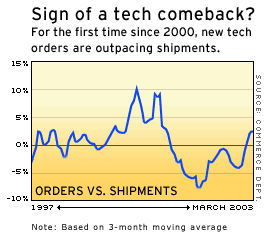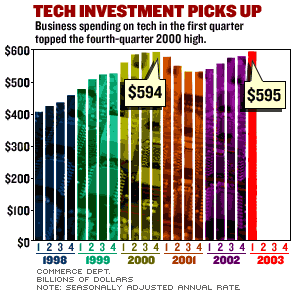NEW YORK (CNN/Money) -
Given the way they've overpromised in the past, you can understand why technology company executives are playing it close to the vest these days. A comeback for tech spending? We're hopeful it's on its way, but we haven't seen it yet.
"The people that make the stuff say that things aren't getting better," said Northern Trust chief U.S. economist Paul Kasriel. "But the data say different."
Indeed, there's a host of economic data suggesting that a revival in spending on technology has arrived:
- According to the Federal Reserve, output at high tech companies was up 9 percent over year-ago levels in March.
- The Commerce Department's durable goods report shows that, for the first time since late 2000, new orders for tech goods are outpacing shipments.
- The latest Gross Domestic Product report showed that spending on "information processing equipment and software" came in at an annualized $595 billion in the first quarter. That was up 10 percent from the first quarter of 2002 and, more strikingly, above the record level for tech spending hit in the fourth quarter of 2000.

This improvement in the tech economy was probably the big reason first-quarter tech company results were such a pleasant surprise. Heading into earnings season, analysts polled by First Call expected earnings for tech companies to be up 10 percent from a year ago. Instead, they're on track for a 16 percent gain. These are the kind of results that make you think that just maybe the analysts' rosy outlook for this year (they expect earnings growth of 29 percent) may have a touch of realism to it.
A question of balance
But a closer look suggests tech's revival may not last for long.
Starting last fall, a number of observers (notably Credit Suisse First Boston strategist Paddy Jilek) argued that tech companies were going to benefit from a massive replacement cycle. Many companies, fearful of Y2K problems, invested heavily in computers and software in the late 1990s. These systems are now rather long in the tooth (the peak growth rates in computer investment occurred from mid-1997 through early 1998) and some are downright obsolete.

The danger is that investors, who have driven the tech-heavy Nasdaq up nearly 40 percent above its October lows, are betting that tech spending is going to keep growing even after all that pre-Y2K stuff gets carted away. They are wrong.
"It seems to me that markets aren't going to be too happy if its just a replacement thing," said Natexis Bleichroeder economic strategist James Padinha.
And the economic data suggest that it is nothing more than a replacement thing. Although tech is doing better, capital spending in general is not. In the first quarter, for instance, spending on new equipment actually dropped, falling to an annualized $981 billion from $992 billion. Take away tech, of course, and the drop is bigger, going to $386 billion from $412 billion.
"That shows that companies are cutting in other areas to prevent their tech infrastructure from becoming obsolete," said Merrill Lynch chief North American economist David Rosenberg.
The implication is that companies are spending on tech not because they want to, but because they have to. And once they no longer have to, their wallets will snap shut again.

|

